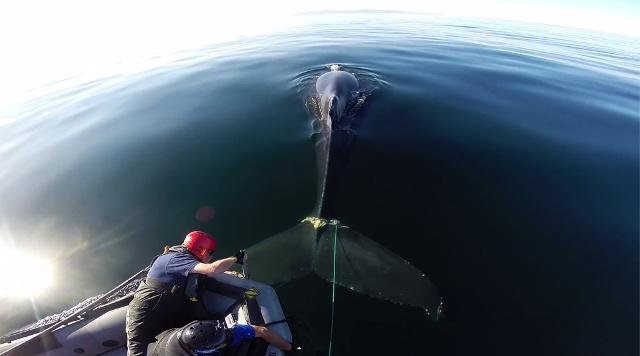SAN JOSE, Calif. -- After a morning spent whale-watching in Monterey Bay, the passengers on the Point Sur Clipper on April 27 didn't notice anything amiss when they first spotted the humpback.
But unlike the other whales, the 25-foot-long young adult stuck near the surface and didn't dive down to feast on the blooms of krill that attract humpbacks to the bay. "It wouldn't fluke up," said Nancy Black, a marine biologist on the ship that day, referring to the picture-perfect tail flip that humpbacks display before diving to feed. Looking closer, the passenger on the Point Sur also noticed several buoys were strangely close to the whale, trailing behind it.
Black called the U.S. Coast Guard, which soon discovered that the whale was ensnared in a crab pot line. That led to a weeks-long rescue effort involving federal and state agencies, six nonprofits, several businesses and dozens of volunteers, who battled rough seas from Monterey to Santa Barbara to give the humpback a shot at survival.
Such large-scale whale rescues are likely to become more common as the population of humpbacks and other whales continues to climb along the California coast, after being suppressed by centuries of whaling. The humpbacks swim north during the spring and summer to feed, clashing with the end of crab season, which in the Monterey Bay extends into July.
Most crab pots are removed from the water in the winter, after the largest crabs are harvested, said Pete Kalvass, a senior marine biologist with the California Department of Fish and Wildlife. So in the past, he said, whales rarely tangled with crab-fishing gear. But in recent weeks, four entangled whales were reported off the West Coast. Two were freed, including a humpback let loose May 6 off the Oregon coast. Crews were unable to attach satellite telemetry tags to two others, and they have not been seen again.
As for the Monterey Bay whale, once snagged, it wasn't easy to free it, the rescuers said as they recounted the adventure.
After Black called the Coast Guard shortly after noon that Sunday, the Coast Guard activated the Whale Entanglement Team, a trained volunteer squad affiliated with the National Marine Fisheries Service. Affectionately called WET, the squad stayed close to the whale, giving the fare-paying passengers on the Point Sur Clipper an extra-long trip.
By 3 p.m., the team had clipped a satellite tag to the gear already wrapped around the whale, so wherever the humpback went, the team could find it. And that was key, said Pieter Folkens, team leader and marine mammal expert.
Early the next morning, a blustery day with choppy seas in the Monterey Bay, the team found the whale again. It was still struggling, breathing often at the surface and swimming slowly.
Armed with long poles and knives, the crew members leaned over the rocking boats, struggling to snip the line. They managed to remove the crab pot and 300 feet of line, but another 50 feet of line remained wrapped around the whale's tail, dragging several buoys.
By then the seas were churning. Swells grew to 10 feet high, tossing the boats up and down.
"I'm calling over, 'You've got to stop,'" said Peggy Stap, a WET member affiliated with the nonprofit Marine Life Studies in Monterey.
Fearing for their safety, the crew members turned back.
Team members spent the next several evenings figuring out the best way to free the whale.
The whale swam south, burdened by the line on its tail. As the winds continued to blow, the humpback zigged and zagged. On May 1, it strayed too far offshore from Big Sur to risk a rescue.
Seven days later, rescuers geared up and headed south to Point Arguello, but at the last minute high seas forced them to stop.
By then, the whale was losing weight, Folkens said. Its swimming was becoming jagged, circular. Rescuers remained onshore, anxiously watching and waiting, Stap said.
As the days passed, the whale's chances of survival dropped. The tissue in its tail had begun to die, said Justin Viezbicke, a WET coordinator with the National Marine Fisheries Service.
Finally, early on the morning of May 15, some 20 rescuers in four boats gathered near Santa Barbara. The water was calm, and the whale was close.
Using hooks and knives, the crews worked for more than an hour. Just before 9 a.m., the last loop was removed.
After swimming some 700 miles entwined in the line, the whale was free.
Folkens, the marine mammal expert, said a poet couldn't describe the rush of emotions he felt when the final bits of line were snipped off.
"It's a combination of feelings of success and accomplishment and being a part of something that makes a difference," Folkens said.
Although other rescuers expressed optimism about the whale's chances, Viezbicke said he really didn't know how the whale would fare.
"It's always very difficult to say," Viezbicke said. "I think the main thing is this animal has a chance now -- and before it didn't."
SundayMonday on 06/01/2014
